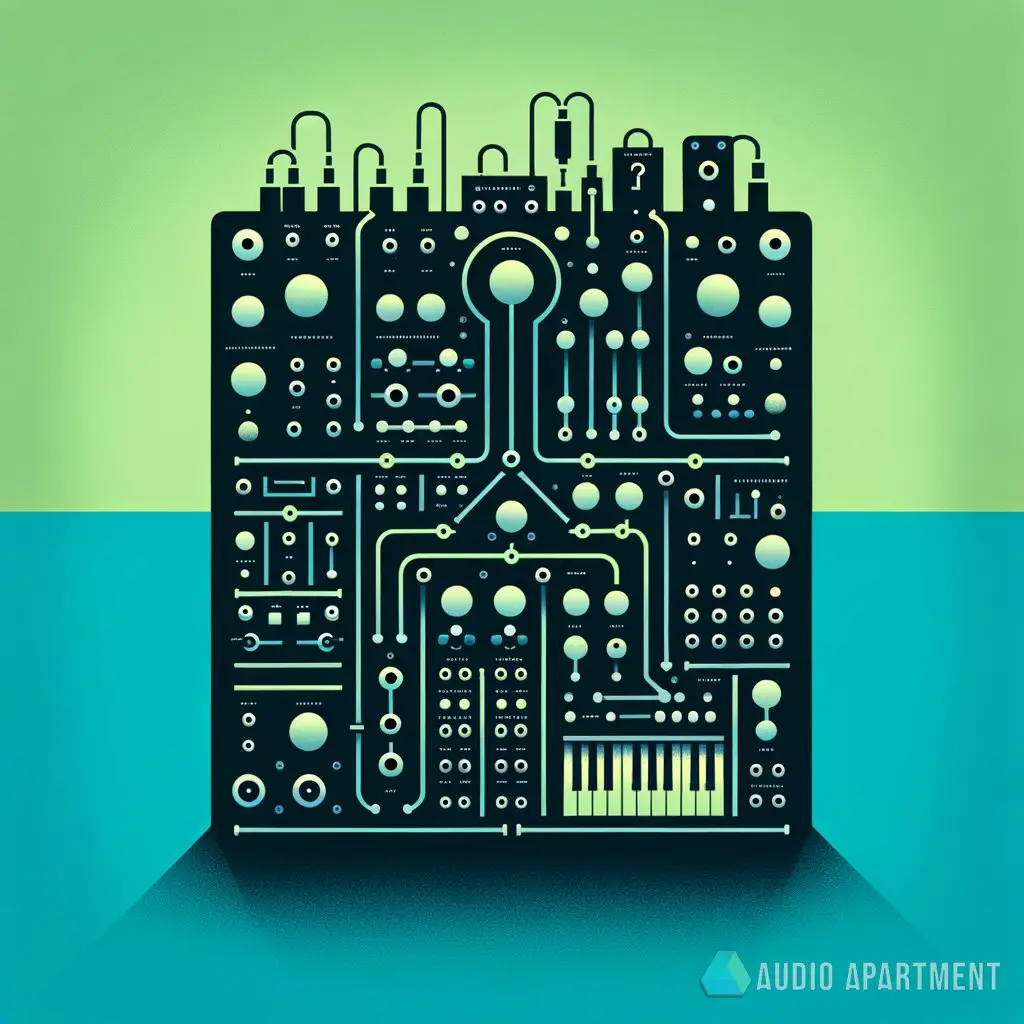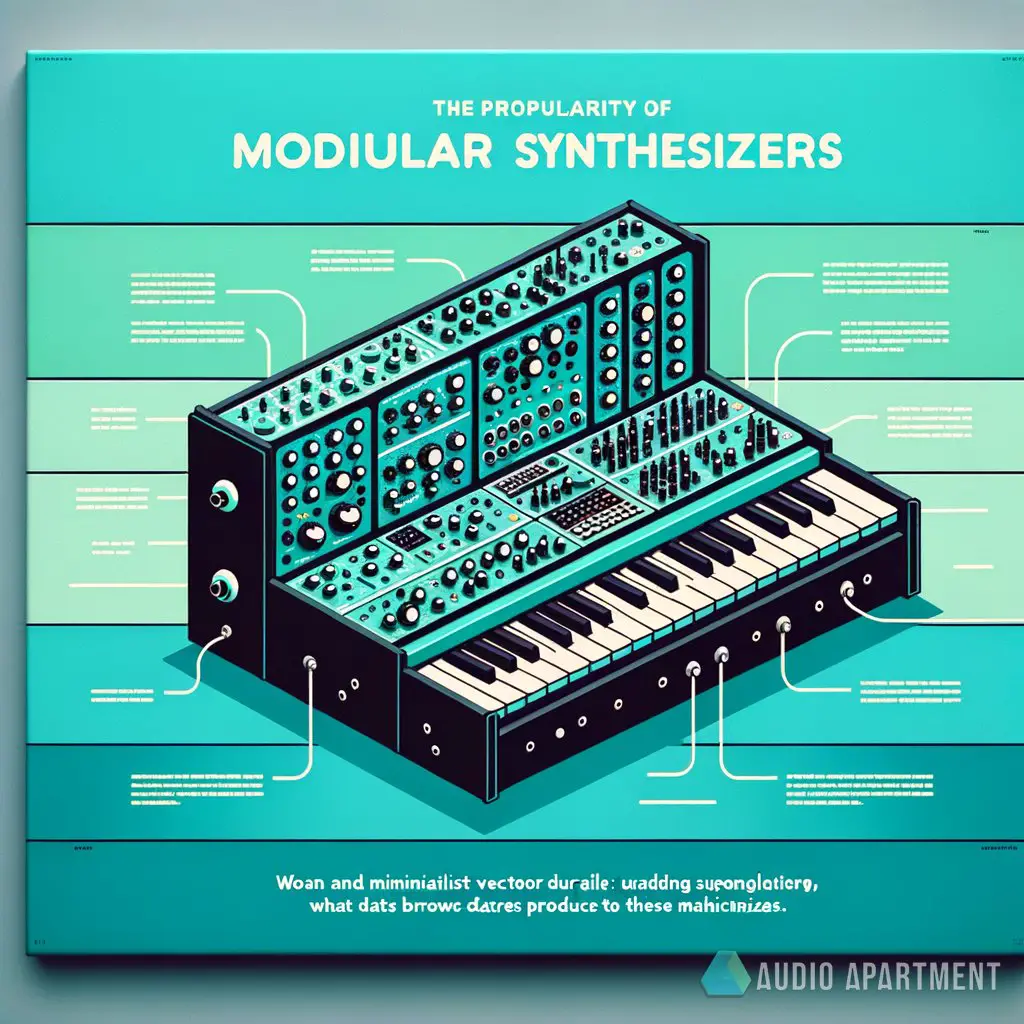Ah, the age-old audio arguments that could set any music forum ablaze quicker than a spilled drink at the bar. You’ll find hot debates scattered like drum fills in a killer solo, whether it’s musing over the crème de la crème of studio gear—or stepping into a street cred squabble about which kicks reign supreme.
In that spirit, just as a musician chooses their studio monitors, we’re diving into the discussion that never fades. Why are modular synthesizers turning the tables in modern music production? We explore the oscillations and modulations that keep this vintage vibe fresh in our digital age.
Key takeaways
- Modular synths offer unparalleled sound customization.
- The tactile control invites more intimate music making.
- They provide a visual understanding of signal paths.
- Community and collaboration are central to the modular experience.
What’s fueling the resurgence of modular synths in today’s studios?
In the labyrinth of today’s music production, modular synthesizers are like the secret passage to Narnia—mysterious and full of endless possibilities. These enigmatic beasts are not just making a cameo; they’re stealing the spotlight in modern music’s narrative.

Why is that? Let’s unpack the reasons modular synths have become the go-to for sonic explorers, from the burgeoning bedroom producer laying down tracks after their bartending shift to the seasoned sound designer sculpting the audio landscapes of tomorrow.
1. Unmatched sound customization
Modular synthesizers offer a level of sound customization that can make even the most seasoned producer’s heart skip a beat. Imagine walking into a studio with the power to conjure any sound your brain whips up—that’s the modular experience.
Each patch you create is a unique audio fingerprint, impossible to replicate entirely. This personal touch is why modular synths resonate so well with artists looking to leave their sonic signature.
With modulars, you’re the sculptor of your own sound, working without presets or limitations. Every knob twist and cable patch is your decision, pushing the boundaries of creativity.
Those looking for a gear staple in their home studio to elevate their craft beyond conventional sound palettes will usually venture into the modular realm, chasing after a sonic chimera that regular instruments and the best MIDI controllers for producers can’t catch.
2. Tangible hands-on control
The tactile nature of modular synthesizers is like flipping through vinyl at a record store; there’s a visceral joy to it that digital can’t touch. Sliding those patch cables into place, feeling the click of a switch—there’s an irreplaceable physical feedback loop that occurs in the process.
It’s the reason why dials and mod wheels beat out mouse clicks: the human touch matters, and in a world where screens dominate, having your hands on the knobs can make all the difference.
This tactile manipulation of sound is not merely about preference; it’s about connectivity. You’re directly plugged into the music-making process, which for many is a game-changer.
The physical interface invites experimental freedom, encouraging producers to go off tangents they might not otherwise explore with a digital GUI. The hands-on approach aligns perfectly with those craving direct manipulation of frequencies, and the best studio monitors can reveal the nuances of these visceral sound explorations.
3. Visual feedback and signal path understanding
One glance at a modular synthesizer and you’ll see the audible in visual form. It’s a patch cable roadmap where each connection demystifies how sound travels and transforms.
This visual feedback is not just for show; it’s an invaluable educational tool, making signal paths and synthesis concepts clear. For those who thrive on visual learning, it’s like hitting the jackpot.
Why does this matter for popularity? Because learning is doing—and seeing—in the modular synth world.
By physically rerouting signals and observing the sonic consequences, budding producers can get a masterclass in signal flow. Such understanding is crucial for anyone serious about diving deep into the essential audio mixing techniques for home studios.
4. Infinite expansion opportunities
With modular synthesizers, you’re not just buying an instrument; you’re investing in an ecosystem. Today’s modular gear is all about expandability—starting with a single module and growing your setup module by module.
This piecemeal approach not only spreads out cost over time but also caters to your evolving musical needs, keeping the setup fresh and adaptable.
The expandability factor contributes to their popularity as it tailors to the producer’s current and future aspirations. Whether adding a complex sequencer or an exotic filter, each addition is a new chapter in your sound story.
Moreover, with options like the Korg volca modular, joining the modular world has never been more accessible, further boosting its widespread allure.
5. Community and collaboration synergy
The modular synth scene is not a solo act; it’s a growing community buzzing with collaboration and innovation. From forums to music shops, the conversations and patch-sharing sessions are akin to bartenders swapping cocktail recipes—it’s both a learning experience and a social one.
“In the labyrinth of today’s music production, modular synthesizers are like the secret passage to Narnia—mysterious and full of endless possibilities. These enigmatic beasts are not just making a cameo; they’re stealing the spotlight in modern music’s narrative.”
This culture fosters an environment where seasoned pros and rookies alike inspire and learn from each other.
This community spirit amplifies the modular synth’s popularity, making it more than a piece of gear but a ticket to a passionate collective. The support and knowledge within the community are as integral as the hardware, and platforms like SoundCloud only stoke this communal fire, offering a space to share and compare the wild audio concoctions born from these modular marvels.
More modular synthesizer tips
As you immerse yourself in the enthralling world of modular synthesis, it’s much like mastering a complex cocktail—both an art and a science. A little guidance can transform a decent experience into an extraordinary one.
Here are some more tips to enhance your journey and ensure that your tracks are not just heard, but felt.
- Experiment with different patch configurations to discover new sounds.
- Integrate your modular setup with other gear using MIDI to expand your sonic palette.
- Regularly attend workshops, meetups, or online forums to learn from the modular community.
- Keep your firmware updated on digital modules to harness the latest features and fixes.
- Invest in quality cables to prevent signal loss and ensure longevity.
- Start with basic modules and gradually add more complex ones as you learn.
- Incorporate field recordings or other non-traditional sound sources to define your unique voice.
When balancing the symphony of knobs and wires that is a modular synthesizer, some sage advice can keep the harmony intact. Here’s a look at the dos and don’ts that could make the difference between a track that slaps and one that merely taps.
| Do | Don’t |
|---|---|
| Do start with a clear concept for your patch. | Don’t rush the learning process—patience is key. |
| Do take the time to understand each module’s capabilities. | Don’t overlook the importance of tuning your VCOs. |
| Do keep your setup neat to avoid cable chaos. | Don’t be afraid to remove modules that aren’t serving your sound. |
| Do back up your module settings if possible. | Don’t neglect your ears—take breaks to prevent fatigue. |
| Do label your cables for complex patches. | Don’t connect outputs directly to outputs. |
Dos and don’ts are stepping stones to mastering modular synthesis.
Advantages and disadvantages of using modular synthesizers
Taking the plunge into modular synths is not unlike deciding to build your own drink mixing station—both come with their set of pros and cons. Modular synths offer unique benefits to the adventurous music producer but bring challenges that require a deft touch to navigate.

Advantages
- Tailored sounds: Customize sounds to your exact specifications.
- Educational tool: Learn the ins and outs of signal flow and synthesis.
- Physical interface: Engage directly with your music through hands-on control.
- Endless creativity: Infinite possibilities for sound design and experimentation.
Disadvantages
- Complexity: Can be overwhelming to understand and operate effectively.
- Space-consuming: Requires physical space for setup, which can grow large.
- Initial cost: High entry price point, especially for a quality setup.
- Time investment: Significant time needed to build and learn the system.
In my opinion, dipping your toes into the world of modular synthesizers feels like the first time you crack open a DAW—intimidating, yet insanely exciting. There’s a steep learning curve, sure, but that moment when you create a sound that’s purely, undeniably yours?
It’s intoxicating. Does that mean modular synths are for everyone?
Absolutely not. But for those willing to weather the complexity for the sake of unparalleled sonic expression, it’s a ride worth every bump.
Now, I’m just an amateur with grand dreams of bringing that 90s alternative flair back to life, with a side of 808s, of course. So, take my words with a pinch of salt—or better yet, a shot of whiskey.
And while you’re debating internally if modular is the way to go, why not ease the decision-making with insights on how analog warmth affects digital recordings?
If you are a visual learner, check out this video titled ‘Modular synth scares me, so I learned how to use it.’
Frequently asked questions (FAQ)
How do modular synthesizers differ from keyboard synthesizers?
Modular synthesizers are comprised of separate, individual components known as modules, each offering distinct sound-shaping functions, whereas keyboard synthesizers usually have fixed signal paths and pre-designed sounds. With modular synths, the artist gets to decide how to wire up these modules, offering immense flexibility and the ability to create unique sounds impossible to get from traditional keyboard synths.
Can a newcomer to synthesis start with a modular synthesizer?
Absolutely! While modular synthesizers seem daunting due to their complexity, beginners shouldn’t be deterred.
Dive in with a basic setup and explore one module at a time. It’s a hands-on learning experience that’s both educational and extremely rewarding.
Remember, every expert was once a rookie twiddling their first oscillator.
Are modular synthesizers only for electronic music genres?
Not at all. Modular synthesizers are extraordinarily versatile and can be found across a spectrum of genres, from ambient, to rock, to hip-hop.
Artists usually use them for the depth, texture, and unique character they can imbue into music, regardless of genre. If you’re creative and like experimenting with sound, modular synthesizers can be an incredible asset to your production toolkit.
Final thoughts
We’ve oscillated through the ins and outs of modular synthesizers—those mysterious boxes of beeps and boops that are staging a comeback. Whether you’re tweaking in your home studio or bending airwaves in a live set, it’s clear that modular synths offer a unique and rewarding experience for those willing to embrace their complexity.
Just like finding your favorite joint to grab a drink, finding your flow with modular synths takes a bit of exploration but pays off with unparalleled artistic expression.
How do you feel about the resurgence of modular synths in the modern music scene? Are they the missing ingredient in your sonic recipe, or just another fad in the ever-changing landscape of music production?
Did I cover everything you wanted to know? Let me know in the comments section belowI read and reply to every comment. If you found this article helpful, share it with a friend, and check out my full blog for more tips and tricks on embracing the modular movement. Thanks for reading and happy synthesizing!
















